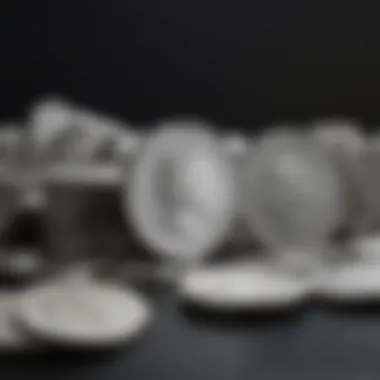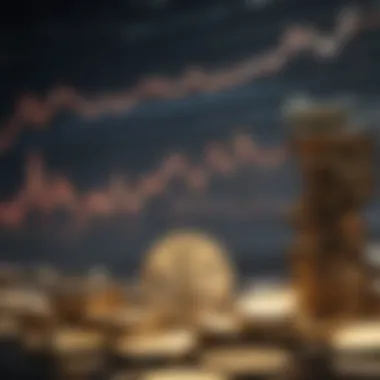Investing in Precious Metals: A Comprehensive Guide


Intro
Investing in precious metals can seem like navigating a maze without a map. Whether you are a novice looking to dip your toes or a seasoned investor seeking new horizons, understanding the foundational aspects of precious metals is crucial. These assets, often seen as a hedge against inflation and economic uncertainty, have garnered attention from various quarters of the finance world. This guide seeks to illuminate key terms, delve into expert insights, and offer concrete strategies for investors eager to enhance their portfolios.
Investment Terminology
Understanding investment jargon can be the first step in demystifying precious metals investment. Being in the know about specific terminology not only aids in making informed decisions but also enhances your overall investment acumen.
Key Terms and Definitions
- Bullion: Typically refers to precious metals in bulk form, valued by weight and purity, like gold or silver bars.
- Spot Price: The current market price at which a particular metal can be bought or sold immediately.
- Numismatic Coins: These are collector coins that have value beyond their metal content, often due to rarity or historical significance.
- Exchange-Traded Fund (ETF): A security that tracks the price of a commodity, such as gold or silver, allowing investors to trade these assets without owning physical metal.
- Hedge: This refers to an investment strategy aimed at reducing potential losses in an asset. Precious metals often serve as a hedge against market volatility.
Common Acronyms in Finance
- IRA: Individual Retirement Account; can include precious metals in self-directed accounts.
- PM: Precious Metals, an umbrella term encompassing gold, silver, platinum, and palladium.
- K: Karat; a measure of the purity of gold. Pure gold is 24K.
Expert Insights
Having the right information is one thing, but insights from experienced investors and financial advisors can take your understanding to another level. Here are some perspectives that can help you navigate the intricate world of precious metals.
Investment Strategies Overview
There are various paths to consider when approaching precious metals. Here are a few key strategies:
- Buy and Hold: This classic approach may fit investors looking to ride out market fluctuations. Buying gold or silver coins or bars to hold for the long term can work well in uncertain times.
- Trading: Short-term trading involves taking advantage of price fluctuations to make quick profits. This demands a sound knowledge of market trends, making it less suited for beginners.
- Diversification: Aiming to spread investments across different types of precious metals can minimize risk. For instance, including both gold and silver in your holdings can provide balance.
"Investing in precious metals is not just about acquiring metals; it’s also about understanding the macroeconomic factors that drive prices."
Tips from Financial Advisors
- Stay Informed: Regularly reviewing market news and trends can offer a competitive edge.
- Consider Authenticity: Only buy from reputable dealers to avoid counterfeit products.
- Evaluate Storage Options: Decide whether you want to store your investments safely at home or prefer a professional storage service.
- Review Regularly: Periodically assess your metals portfolio to align it with your changing financial goals and market conditions.
By understanding these fundamental terms and strategies, you not only enhance your potential for success but also bolster your confidence in making investment decisions in the precious metals market.
Understanding Precious Metals
In today's financial landscape, understanding precious metals is crucial for any investor looking to diversify their portfolio. Precious metals like gold, silver, platinum, and palladium each have unique qualities and benefits that can significantly impact wealth preservation and growth over time. Precious metals serve not just as tangible investments but also as a hedge against economic fluctuations and inflation.
Definition and Types
Gold
Gold is often seen as the king of precious metals. Its unique yellow luster and scarcity make it incredibly appealing for investors and collectors alike. Gold holds a historical significance, having been used by ancient civilizations for coins and jewelry, and it still plays a vital role today. Its primary characteristic is its ability to maintain value, even during turbulent times. With a high demand that outstrips supply, it often appreciates, making it a favorite choice.
Advantages of Gold:
- Recognized globally as a store of value.
- Generally more liquid than other assets, meaning you can quickly buy or sell it in most markets.
- Less volatile compared to stocks and bonds, which brings stability to a portfolio.
Silver
Silver is known as the "poor man's gold" but shouldn't be underestimated. Its industrial uses, especially in electronics and renewable energy sectors, give it an added layer of value. Silver's characteristic reflective quality and lower price point make it accessible, allowing even modest investors to include it in their portfolios.
Advantages of Silver:
- Strong industrial demand which supports price increases.
- More affordable entry point compared to gold, appealing to new investors.
- Historical significance as a form of currency and investment.
Platinum
Platinum is rarer than gold and silver, offering a unique investment opportunity. It is mainly used in the automotive industry for catalytic converters, giving it industrial benefits. Its lustrous appearance also makes it a choice for fine jewelry. Many investors appreciate platinum for its distinct status as a luxury metal.
Advantages of Platinum:
- Rarity enhances its potential value and investment appeal.
- Industrial applications can drive demand, affecting price positively.
Palladium
Palladium has gained attention in recent years, particularly due to its use in the automotive sector and electronics. This precious metal is often favored for its lower price point compared to platinum, yet it offers similar investment benefits. Investors might find palladium to be a good way to diversify their holdings.
Advantages of Palladium:
- High demand in catalytic converter production, helping maintain its value.
- Often seen as a more affordable option in the luxury metal market.
Historical Context
Ancient Civilizations
Ancient civilizations understood the value of precious metals, using them not merely as currency but as status symbols and for craftsmanship. Gold and silver were utilized in trade and as offerings in religious practices, forming a foundation for today’s global markets. The symbolic nature of these metals still influences how we perceive them today.
Relevance of Ancient Civilizations:
- They established a societal framework that regarded precious metals as wealth, influencing modern investment approaches.
- The craftsmanship and artistry involved in their use have left a legacy that continues to attract collectors and investors.
Modern Usage
In contemporary society, precious metals have solidified their status as critical components of financial strategies. They function as a safe haven during times of uncertainty. Moreover, the advent of new technologies has broadened the use of silver and platinum in various industries, enhancing their demand and value.
Modern Usage Highlights:
- They are seen as a hedge against inflation and currency fluctuations.
- Investment demand continues to grow due to the limited supply scenarios in specific markets.
Investment Evolution
The landscape of investing in precious metals has transformed significantly over the years. From being viewed primarily as physical commodities, there is now a plethora of avenues available for investment—from ETFs and mining stocks to digital platforms for trading.


Investment products have evolved, providing investors with greater flexibility and choice. A thorough understanding of these options is essential for any serious investor to navigate the current market effectively.
Investment Evolution Aspects:
- Greater accessibility through various investment vehicles catering to diverse preferences.
- The integration of modern technology plays a pivotal role in shaping investor behavior and market patterns.
The Importance of Precious Metals in Investment
Investing in precious metals has become increasingly pivotal in contemporary financial strategies. These metals, primarily gold, silver, platinum, and palladium, serve not just as traditional hedges against market downturns but also as vital components in risk management and portfolio diversification. The stability that precious metals provide allows investors to withstand economic fluctuations, making them an essential part of any well-rounded investment approach.
Role in Diversification
When it comes to risk management, precious metals play a crucial role in helping to diversify an investment portfolio. Diversification means spreading investments across various asset classes, which in turn minimizes risk—a principle every investor should take to heart.
Volatility Management
One of the standout features of volatility management is its ability to buffer against sharp market dips. Precious metals often move contrary to stock prices; when the market goes south, metals like gold usually hold their own. This inverse relationship proves to be quite beneficial as it enables investors to maintain a stable portfolio value.Additionally, these metals tend to have a relatively low correlation with equities, making them a smart choice for those looking to cushion their investments from unpredictable shifts in the market.
Asset Correlation
The key characteristic of asset correlation is the interdependence of different investments. Precious metals have historically exhibited unique correlation patterns. By incorporating them into an investment mix, one can reduce the overall risk exposure. They perform differently under various economic conditions, allowing for a more balanced portfolio. This characteristic is particularly beneficial in periods of uncertainty, as assets that don’t move in sync with others can help cushion the impacts of market shifts.
Hedge Against Inflation
Precious metals are often viewed as a refuge during inflationary periods. Their intrinsic value tends to remain steady or even increases, providing security when inflation erodes the purchasing power of traditional currencies. The uniqueness of metals as a hedge lies in their ability to act as a reliable store of value over time. However, while they provide this assurance, it’s also essential to acknowledge that relying solely on them for protection against inflation might limit other growth opportunities.
Economic Indicators
Through understanding economic indicators, investors can stay ahead of the curve and make informed decisions regarding precious metal investments.
Market Trends
Market trends significantly shape the landscape of precious metals. Monitoring fluctuations can provide invaluable insights into when it’s advantageous to buy or sell. Prices can be swayed by a multitude of factors including global economic conditions and changes in demand. Investors who stay informed about these trends can adjust their strategies accordingly, either capitalizing on bullish runs or safeguarding against anticipated downturns. Grasping these patterns can make or break an investment approach.
Geopolitical Factors
Geopolitical factors often act as catalysts for the price movements of precious metals. Events such as conflicts or political instability can lead to increased demand for these assets as safety nets. Historically, during crises, investors flock to gold and silver, thereby driving their prices upward. Understanding this dynamic can provide investors a clearer picture of market behavior during uncertain times, revealing opportunities to either protect or grow their investments.
Supply and Demand Dynamics
The interplay of supply and demand is critical in determining the market value of precious metals. Limited supply combined with increasing demand, especially from emerging economies, tends to push prices higher. It’s the classic economic principle—when demand outstrips supply, prices rise. For investors, keeping an eye on these dynamics is paramount as it informs decisions on timing investments in these metals. Recognizing shifts in demand from different sectors can also provide an edge, influencing when to enter or exit the market.
"Understanding the intricate relationship between these elements not only strengthens your investment strategy but enhances your capability to make calculated decisions in response to fluctuating market conditions."
In summary, understanding the importance of precious metals extends beyond mere possession; it's about integrating them intelligently into one's investment strategy. By leveraging their intrinsic characteristics, investors can cultivate a robust, balanced, and resilient portfolio.
How to Invest in Precious Metals
Investing in precious metals holds a significant place in financial strategies for many individuals. These tangible assets not only serve as a safe haven during turbulent economic times but also offer a solid ground for diversification in an investment portfolio. Knowing how to invest wisely can mean the difference between a fortunate gain or a staggering misstep.
Physical Ownership
Coins and Bars
When it comes to physical ownership of precious metals, coins and bars are two of the most notable options. Coins, often featuring historical figures or iconic designs, hold a dual appeal—collectible value and intrinsic metal worth. Bars, on the other hand, cater more to bulk investors, offering greater quantities at a potentially lower price per ounce. Investing in coins is popular among collectors, but bars might attract those who want large amounts of metal without the collectible premiums.
A unique aspect of coins is that their value can be influenced by rarity, condition, and market demand; this adds an interesting dynamic beyond just the metal's value. However, collectors ought to tread carefully, as not all coins will appreciate at the same pace, making knowledge of trends vital.
Storage Considerations
Storing precious metals safely is a critical element that can't be overlooked. Whether you decide on a safe at home or a safety deposit box, the storage method can greatly affect your investment's safety and accessibility. One key characteristic of secure storage is ensuring it is fireproof and burglar-resistant, safeguarding your investment from both theft and disasters.
Although storing at home may provide immediate access, it also poses greater risks. Conversely, professional vaulting services provide peace of mind, but may involve additional costs. It’s essential to weigh convenience against security when determining storage options.
Insurance Needs
Insurance can be an important aspect of protecting your precious metal investments. With the right policy, you can safeguard your assets from theft, loss, or damage. The distinctive feature of insurance is that, with a good policy in place, you can mitigate the financial impact of unforeseen events.
However, not all insurance policies cover precious metals at their full market value, so research is key when selecting coverage. Understanding the details of such policies helps ensure you're not left in a lurch during a crisis.
Paper Investments
As more investors delve into precious metals, paper investments have emerged as viable alternatives to physical ownership. These methods allow individuals to gain exposure without the need for storage and insurance, which can be appealing.
ETFs
Exchange-traded funds (ETFs) are investment funds that are traded on stock exchanges, representing the value of physical precious metals. One of the main attractions of ETFs is their liquidity—they can be bought or sold like stocks. This ease of trading makes it a beneficial choice for those who prefer flexibility.
A unique attribute of ETFs is the way they mirror market changes, giving investors instant visibility on how their investment performs against actual gold or silver prices. However, investors must pay attention to management fees that can eat into returns over time.
Mining Stocks
Mining stocks provide a different avenue to invest in precious metals, as they represent shares in companies involved in extraction processes. One essential aspect of mining stocks is that they aren't solely tied to the price of the metal; the efficiency and success of the company greatly influence stock performance.
Investing in mining stocks can be a double-edged sword—while significant gains can be achieved, they can also lead to losses if the company encounters operational difficulties or if metal prices decline. Understanding the operational landscape of mining companies is crucial.
Mutual Funds
Mutual funds that specialize in precious metals can be appealing for those looking for a more diversified approach. By pooling together assets from various investors, mutual funds spread risk over multiple investments. One key characteristic of mutual funds is professional management, which can ease the learning curve for new investors who are still grasping market dynamics.
On the downside, mutual funds usually charge management fees, and the performance can lag behind direct investment in precious metals. Investors should consider both the fees and potential returns when exploring this option.
Incorporating both physical ownership and paper investments in a strategy allows investors to adapt to their financial goals and market conditions. As you contemplate precious metals as an asset class, carefully assess the various options, recognizing that each path offers unique benefits and challenges.


Recognizing Market Trends
Recognizing market trends is essential in any investment strategy, particularly in the realm of precious metals. Understanding these trends not only equips investors with necessary insights but also enables them to make informed decisions. The fluctuations in the market can be attributed to a multitude of factors such as economic indicators, global events, and changes in investor sentiment. In this section, we will delve into the current market analysis and future projections, which are crucial for anyone looking to navigate this complex environment effectively.
Current Market Analysis
Recent Price Movements
A close examination of recent price movements reveals much about the current state of precious metals. Prices can shift dramatically in response to market stimuli, and these fluctuations are invaluable for investment strategies. It is common to see gold and silver prices react sharply during economic uncertainty, which highlights their roles as safe havens.
For instance, if gold experiences a notable spike, it often indicates heightened investor anxiety regarding the stock market or geopolitical tensions. The key characteristic of these movements is their ability to signal opportunities. Investors can leverage these trends to buy at relatively lower points, although risks remain in interpreting such data accurately. The unique advantage of monitoring price data lies in its immediate availability, enabling quick decisions. However, overreaction to short-term movements can mislead investors into making hasty choices.
Investor Sentiment
Investor sentiment is another vital piece in the puzzle of market analysis. It often dictates the flow of investment, especially during periods of high volatility. Gauging how investors feel—optimistic or pessimistic—can significantly influence buying and selling behaviors amidst chaos.
This characteristic is beneficial because it can help predict market turns before they occur. For example, if sentiment indicators suggest a shift to bullishness, it may lead to increased buying of precious metals, thereby driving prices up. Observing social media platforms like Reddit or Facebook for sentiment analysis has become a popular strategy in recent years, allowing real-time insight into market psychology. However, relying too heavily on sentiment can lead to pitfalls, given that emotions often govern investor decisions rather than rational analysis.
Technical Analysis Techniques
Utilizing technical analysis techniques adds a layer of sophistication to market trend recognition. These methods involve studying historical data to predict future price movements through various charts and indicators. Drawing patterns from past trends can help investors gauge potential turning points in precious metals.
One of the hallmark features of technical analysis is that it relies on quantifiable data rather than subjective interpretation, rendering it a favored approach among seasoned investors. For example, moving averages are commonly used to smooth out price data, making it easier to understand overall trends. Despite its strengths, it's important to consider the limitations of technical analysis; past performance is not always indicative of future results, and reliance solely on these techniques can lead to misguided strategies.
Future Projections
Expert Opinions
Expert opinions serve as a compass in navigating future projections for precious metals. Analysts and market veterans often share their insights based on extensive experience and data analysis. Many believe that rising inflation rates and economic uncertainty will play a pivotal role in driving precious metal prices in the coming years.
This characteristic—grounded in expertise—provides valuable perspectives that can help investors strategize. Engaging with analyses from reputed financial sites can enrich one's understanding, although it is important to consider diverse viewpoints to avoid a narrow perception of trends. The limitation, however, is that predictions can be inherently uncertain and may not always materialize as anticipated.
Historical Patterns
Exploring historical patterns can offer a pragmatic lens through which to view the future. Examining how precious metal prices have reacted to similar economic climates in the past can inform present-day strategies. For instance, historical data often reveals that gold prices tend to rise during economic downturns as investors seek stability.
The ability to draw parallels from history makes it a powerful tool for forecasting. However, one must remember that conditions change; what worked in the past may not be relevant today. Thus, while historical analysis is rich in data, it should be supplemented with current market observations.
Emerging Markets
Emerging markets present a dynamic opportunity in the context of precious metals investment. Countries undergoing economic transitions can drastically affect the demand for and supply of these metals. For example, as industrialization increases, nations such as China and India display substantial appetite for gold and silver, propelling prices upwards.
The key characteristic of emerging markets is their unpredictability and potential for rapid change, which can yield significant returns. On the flip side, these markets can also introduce a range of risks, including political instability and regulatory challenges, requiring cautious navigation.
In summary, recognizing market trends in precious metals is an indispensable skill for investors. By understanding current analysis, assessing future projections, and weighing expert opinions against historical data and emerging market conditions, one can build a robust strategy. This comprehensive approach allows investors to stay ahead of the curve in a fluid market.
Legal and Regulatory Considerations
Understanding the legal and regulatory framework surrounding precious metals investment is essential for anyone involved in this market. Laws and regulations not only dictate the legality of transactions but also establish safeguards that protect investors from potential pitfalls. Awareness of these legal parameters can mean the difference between a solid investment and a costly mistake. It’s akin to knowing the rules of the road before setting out on a drive; it ensures you stay on course and avoid unnecessary risks.
Tax Implications
Capital Gains Tax
When it comes to selling precious metals, one of the most significant financial considerations is the capital gains tax. This tax applies to the profit made from the sale of an asset, including gold, silver, and other precious metals. In the U.S., if you've held these assets for more than a year, the long-term capital gains tax rate tends to be more favorable than short-term rates. This aspect encourages investors to hold onto their metals longer, betting on a price increase over time.
A unique feature of the capital gains tax is that it varies by income level, meaning higher earners might face a steeper tax rate. This could dissuade some shareholders from liquidating their investments too quickly. Therefore, understanding how this tax impacts your returns can help you strategize better.
Sales Tax
Sales tax applies when buying certain physical precious metals. Not all states impose this tax, but in states that do, it can add a significant percentage to the overall cost of acquiring these assets. The critical characteristic here is that while the investment itself may appreciate, the added cost of sales tax can diminish your immediate profit margin.
The unique downside of sales tax is that it can deter you from making small purchases or diversifying your holdings. If you’re planning to invest significantly, being aware of your state’s sales tax policies can lead to better financial decisions in the long run.
Reporting Requirements
Investors need to be conscious of reporting requirements when it comes to precious metals transactions. The IRS, for example, requires reporting for gains from selling precious metals over certain thresholds. This is vital because failing to report can lead to serious penalties. The key feature of these requirements is their intent to maintain transparency in transactions, which ultimately benefits the market by reducing fraudulent activities.
The challenge here lies in the documentation that must be maintained, as it can become cumbersome. A clear understanding of what's needed can save you from a lot of headaches come tax season.
Regulatory Bodies
Commodity Futures Trading Commission
The Commodity Futures Trading Commission (CFTC) plays a pivotal role in regulating the trading of precious metals futures and options. It monitors market activity for illegal practices, ensuring that trading remains fair for everyone involved. The key characteristic of the CFTC is its proactive stance against market manipulation, safeguarding the integrity of the trading environment.
One unique benefit of this regulatory oversight is that it can enhance investor confidence. Knowing there’s an authority watching over the market can make it easier to enter trades without the fear of being ripped off or dealing with dubious sellers.
Federal Trade Commission
The Federal Trade Commission (FTC) is another vital player in ensuring that precious metals transactions are conducted fairly and truthfully. It protects consumers from misleading advertising and unfair business practices. Its key feature is its broad reach, which covers various sectors but also extends to precious metals dealers.
The advantage of FTC regulations is that they create a safer marketplace for consumers, empowering them to make informed decisions based on truthful and accurate information. As a consumer, being aware of the FTC's role allows you to recognize practices that may seem suspicious.
State Regulations
Each state has its own set of regulations that affect the buying and selling of precious metals. These state regulations can cover everything from licensing requirements for dealers to tax laws and consumer protection measures. A significant characteristic of state regulations is their localized nature; what applies in California may not be relevant in New York.
The unique feature is that while they can offer protection, state regulations may also vary widely, creating a patchwork of rules that can be confusing. Investors must navigate these waters carefully to ensure compliance and avoid legal troubles.
Being familiar with local laws and regulations not only protects you but also enhances your investment strategy. Every little detail counts in this market.
Common Pitfalls and Risks


Understanding common pitfalls and risks is vital for anyone stepping into the realm of precious metals investment. While the allure of these materials is undeniable, potential investors need to know the traps that might lurk in the shadows. Recognizing these pitfalls not only prepares your mind but also helps safeguard your financial interests. Many individuals fall prey to the excitement of shiny coins and bars without fully comprehending the risks involved. This section highlights key areas to be mindful of, ensuring that you tread carefully in the investment landscape.
Market Volatility
Price Fluctuations
Price fluctuations are one of the most significant factors affecting the value of precious metals. The market for these assets is rarely static; it moves up and down based on numerous factors, such as economic conditions, geopolitical events, and even simple investor sentiment. These swings can happen quickly and without warning. One key characteristic of price fluctuations is their unpredictability. This volatility can be both an opportunity and a risk. For instance, while a sudden drop in prices could allow savvy investors to buy low, it can also lead to panic selling among more cautious individuals.
The unique feature of price fluctuations is the drastic effect they have on short-term traders. Those who attempt to time the market may find themselves in a precarious spot, facing potential losses if they misjudge the market's direction. Though experiencing highs can be thrilling, the reality of downside risks means investors should think long-term to avoid getting swept up in the daily price dance.
Investment Timing Risks
Investment timing risks are closely linked to market volatility. This aspect requires keen attention, as the right moment for buying or selling can mean the difference between profit and loss. Timing the market can often feel like a game of chance. The key element here is the compulsion to act based on fleeting sentiments or headlines. Such actions can lead to ill-timed decisions, turning an investment dream into a financial nightmare.
Investors need to be wary of the urge to react impulsively to minor market movements or news reports. The unique feature of timing risks lies in the unpredictability of the market's response to global events. External circumstances can evoke immediate reactions, but they may not always align with long-term trends. It’s wise to approach investments with a patient mindset, exploring opportunities rather than chasing every tick of the market.
Fraud and Scams
Identifying Red Flags
When investing in precious metals, recognizing red flags is crucial. The market has its share of less-than-reputable dealers and schemes, and being aware of potential warning signs can save you from significant losses. One of the most telling signs is overly aggressive sales tactics accompanied by promises of guaranteed returns. If it sounds too good to be true, it deserves a second look. Consumers should also be mindful of the rarity of information available about certain dealers online.
Another important aspect of identifying red flags is transparency. A trustworthy dealer should provide clear information regarding pricing, authentication, and buying conditions. Lack of documentation or the hesitance to answer questions might signal that you should steer clear.
Safe Trading Practices
Safe trading practices are an investor's best friend when it comes to navigating the potential pitfalls of the precious metals market. This involves conducting thorough research and taking extra precautions when making transactions. One of the hallmark practices is utilizing secure payment methods and dealing with accredited dealers. Implementing these steps helps shield you from scams and secures your investments.
Additionally, using escrow services can be a safeguard to ensure that both parties meet their obligations before funds change hands. Maintaining diligence does require effort, but it’s worth it to protect your hard-earned money. Proper diligence means not just looking for bargain deals; it's about safeguarding your investment by dealing with established entities.
"Investing in precious metals is a journey often filled with research and due diligence, but the rewards can be significant when you navigate the landscape carefully."
Understanding these common pitfalls and actively avoiding them is instrumental in paving the way for a successful investment venture. By staying informed and keeping a watchful eye, investors can mitigate risks and enhance their chances of realizing gains in their precious metals investments.
Evaluating Precious Metals Dealers
When it comes to investing in precious metals, selecting a reliable dealer is crucial. A reputable dealer not only enhances your purchasing experience but also significantly influences the value of your investment. Knowing how to evaluate dealers helps to minimize risks and ensures that you're making informed choices that could protect your hard-earned money.
Reputation and Trustworthiness
Researching Dealers
Diving into researching dealers is all about making sure you’re not getting the short end of the stick. Look for established players in the marketplace. Key characteristics of researching dealers includes checking how long they've been in the business and what kind of footprint they’ve left.
One notable aspect of research is online visibility; a dealer with a strong internet presence, including informative websites and transparent operations, is likely a safer bet. You might be thinking, why not just go to the one that pops up first in a search? Well, sometimes the top search results are merely via paid ads, not genuine quality. This research allows you to differentiate between trusted sources and those that might just be taking you for a ride, which, let’s face it, is not a gamble you want to take.
Another advantage of diligent researching is that it tends to uncover background checks and insights that can guide your decision positively or highlight potential risks. Be sure to take your time and comb through everything thoughtfully.
Customer Reviews
Customer reviews can often act as a digital pulse check on a dealer's operations. When you come across reviews, look closely at the specifics—were the customers satisfied with their transactions? Did the dealer live up to their promises? The key characteristic here lies in real user experiences; these can provide a window onto how the dealer handles issues like customer service and product quality.
What’s unique about customer reviews is that they spotlight the dealer’s performance over a period. A dealer might shine for a while, but a consistent stream of negative feedback can indicate deeper issues. Therefore, read between the lines. These insights tend to enhance your understanding and steer you clear of potentially problematic dealers—saving you from trying to recover your funds later.
Accreditation Bodies
Acquiring precious metals from dealers who are accredited by recognized organizations boosts your confidence as an investor. Accreditation bodies like the American Numismatic Association (ANA) provide guidelines aimed at consumer protection. It shows a dealer is bound by certain standards, fostering a level of trustworthiness.
The hallmark of accreditation lies in the adherence to ethical practices and a commitment to transparency. Such bodies often publish lists of vetted dealers, making it easier for you to find options that align with your investing ethos. A credentialed dealer with a strong history can be a weighty advantage—inspecting their endorsements will save you the hassle of swimming in uncertainty.
Pricing Structures
Understanding pricing structures is just as crucial as evaluating dealers. This facet helps in comprehending the financial implications of your investment.
Spot Price vs. Premiums
Spot price is the market price for immediate delivery of a precious metal, while premiums are the costs added above that spot price. The critical aspect of spot price vs. premiums is to recognize how premiums can change based on dealer pricing strategies and market conditions. It’s advisable to shop around and understand the factors behind these premiums before deciding on a purchase.
The uniqueness of this pricing structure is that it provides insight into market sentiment—if premiums skyrocket, it can hint at increased demand or limited supply. However, sometimes dealers inflate premiums; thus, being armed with price knowledge can be a game changer in negotiations.
Understanding Markups
Understanding markups is pivotal not just for comprehension but for smart investing. Markups are the additional amounts charged on top of the metal's spot price. A key characteristic of markups is that they can vary widely among dealers—a quick way for them to enhance profits, often without transparency.
The ability to understand markups allows you to gauge whether the price you’re being offered is fair. Some dealers might be straightforward, while others may capitalize on your lack of market knowledge. It's crucial to take time comparing these markups with different dealers. If you miss out on this, you might just find yourself paying through the nose.
Remember: Knowledge is your best ally in the world of precious metal investments. Getting the best value means being astute about who you buy from and how much you’re paying.
Closure
As we draw this extensive exploration of precious metals investing to a close, it's crucial to acknowledge the multifaceted nature of the topic. Diving into the conclusions, we find ourselves summarizing the various paths we've traversed—laying out definitions, grappling with historical contexts, and enlightening readers about both the potential rewards and pitfalls of the market.
Summary of Key Points
In summary, several critical aspects emerge from our discussion:
- Types of Precious Metals: Gold, silver, platinum, and palladium each hold unique value propositions for investors. Understanding these differences is key for making informed choices.
- Investment Importance: Precious metals serve as an essential part of a well-rounded investment strategy. They not only diversify portfolios but also act as a safeguard against inflation and economic instability.
- Investment Avenues: Whether choosing physical ownership like coins and bars or delving into paper investments such as ETFs and mining stocks, investors have multiple options to consider.
- Market Dynamics: Awareness of current trends and future projections can greatly influence investment decisions. Understanding expert insights and historical patterns is vital for predicting potential market shifts.
- Legal and Regulatory Frameworks: Grasping the tax implications and the role of regulatory bodies helps ensure a compliant and secure investing experience.
- Evaluating Dealers: Choosing reputable dealers is paramount. The reputation and pricing structures of dealers can have a significant impact on the overall investment results.
Final Thoughts on Investment Strategy
Investing in precious metals is not merely a trend but a time-honored strategy that resonates with both seasoned investors and those just beginning their journey. It's about striking the right balance in one’s investment portfolio. Investors should take into account their individual risk tolerance, financial goals, and long-term strategies when integrating precious metals into their financial plan.
Ultimately, knowledge is power. By comprehensively understanding the intricacies of precious metals—from market trends to the importance of trustworthy dealers—investors can emerge more confident in their decisions. Diversification is not just a buzzword; it is an explicit necessity in today's ever-fluctuating financial landscape.
As we wrap up, remember that every investment carries a degree of risk, and staying informed, flexible, and prepared is the best strategy to navigate this complex environment. Whether you're in for the long haul or merely dabbling in the domain, understanding the depth of each aspect of precious metals will serve you well in achieving your financial objectives.
"The key to investing lies in the blend of knowledge and patience."
Be it gold or silver, the journey through precious metals could very well be a rewarding one.















